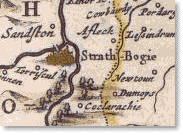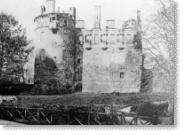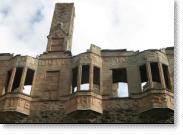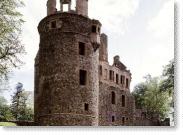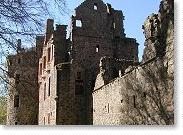David of Strathbogie chose to support the English early in 1314 before King Robert the Bruce's final victory at Bannockburn, and for which his lands and titles were confiscated and granted to Sir Adam Gordon of Gordon and Huntly in Berwickshire; bringing the family of the Gordons to the north and with them the name of Huntly that was to later replace Strathbogie. However, Sir Adam Gordon died in 1402 at the Battle of Homildon Hill without male heirs, and his daughter Elizabeth Gordon was to became heiress of the whole of his estates, marrying Sir Alexander Seton of Seton by Royal arrangement and bringing the Seton's to Aberdeenshire.
Sir Alexander Seton was the second son of the noble Sir William Seton of Seton, 1st Lord Seton in East Lothian, and was himself created Lord Gordon. He was one of the Scots nobles who attended Princess Margaret of Scotland on her marriage to the dauphin Louis, son of Charles VIII of France. The following year he was sent to England to negotiate a treaty of a peace and dying in 1440, was succeeded by his eldest son, also Sir Alexander Seton; his second son Sir William Seton founded the Seton's of Meldrum in Aberdeenshire; and his 3rd son Sir Henry Seton died without heirs along with his brother William at the Battle of Brechin. It was the 1st Lord Gordon who built the first stone tower was burnt by the Earl of Moray as part of the contest between James II and his unruly subject, the Black Douglas.
In about 1410, the 1st Lord Gordon, cleared away the 230 year old wooden structure and replaced it with a stone tower house built at the north end of the bailey. Only the thick-walled foundations of the tower house now remain, visible on the north side of the castle courtyard, but the tower house would have been accompanied by a defensive wall around the bailey area, and ranges of other supporting buildings. This castle was burned by the Earl of Moray in 1452, and the damaged tower house at Strathbogie was replaced in 1460 by a much grander building on the south side of the site, where all later development was to take place. Today only the cellars under the later palace remain of the 1460 building.
The 2nd Lord Gordon was first Lord of Badenoch and Cluny, and also of Midmar before succeeding to his father's estates, and after the succession to the Lordship of Gordon he was raised to become the 1st Earl of Huntly. During his lifetime, the Strathbogie Castle was greatly expanded, adding wings to form an L-plan extending out from the main tower.
He was thrice married, and had issue as follows: by his first wife, Jean, daughter and heiress of Robert de Keith, grandson and heir of Sir William de Keith, Great Marischal of Scotland, he had no issue; by his second wife, Egidia Hay, daughter and heiress of Sir John Hay of Touch and Tullibody he had a son Sir Alexander Seton, who was to inherit his mother's estates and found the Seton's of Touch and Tullibody, and of Abercorn who themselves eventually became heirs to the Lordship of Gordon, and later still to the lineal Seton-Honours (maternally).
By his third wife, Elizabeth, daughter of William, Lord Crichton, the powerful Lord High Chancellor of Scotland, he had three sons and three daughters, some of which later took the name of Gordon and the succession to the Earldom of Huntly being settled on the issue of this marriage by charter, 29 Jan. 1449. The three sons were: George Seton, 2nd Earl of Huntly (later George Gordon); Sir Alexander Seton of Midmar (later as Gordon) and ancestor of the Gordons of Abergeldie; and Adam Seton, Dean of Caithness and Rector of Pettie; and those and who later adopted the surname of Gordon. continued the line as the Gordon Earls, Marquis' and Duke's in Aberdeenshire.
The grand castle of Huntly saw many visits from royalty, and figures prominently in Scottish history: Sir Robert Bruce rested in the motte in 1307; James IV attended the marriage of the pretender to the English throne, Perkin Warbeck, to Lady Catherine Gordon 'the White Rose of Scotland' in January 1496 in the third castle; in 1556 the Queen Regent, Mary of Guise, visited officially as the chief stronghold of the Catholic Seton-Gordon Earls of Huntly was to have become the headquarters of the counter-reformation in Scotland. In that year, after the Earl of Huntly's defeat at Corrichie (at the hands of Mary Queen of Scots) the castle was pillaged, the contents including the treasures of St Machar's Cathedral, Aberdeen.
Architecturally the L-plan castle of Strathbogie consisted of a five-story tower with an adjoining great hall and supporting buildings around a courtyard, and fragments of the original ornate facade and interior stonework remain. As the castle was expanded, and wings were added in the 16th century, Alexander the 3rd Earl of Huntly was granted a charter changing the name and surrounding area from Strathbogie to Huntly, in 1506, in effect fitting the geography to his title and has since been known as Huntly Castle, as well as the town to its south.
In 1550 George, the 4th Earl of Huntly was also Lord Chancellor of Scotland and one of the wealthiest men in the kingdom, and he and rebuilt the old structure above the basement level into a grand palace echoing the work of his Seton-cousin's to the south and finishing the work just in time for the visit by Mary de Guise, widow of King James V and mother of Mary Queen of Scots. He had visited France with Guise and by 1556, his 'new wark', the grand palace-block (or 'palatium' hall), had been created on the south side of the courtyard.
However George's strong Catholicism and political independence were later to lead to his falling out with the Royal Court and personally with Queen Mary. She defeated him at Corrichie on the Hill o' Fare (1562), and as Huntly Castle being a Gordon house had become the focus of Roman Catholic opposition to the Reformation, it was beseiged, damaged and looted as a result and the treasures carried off, including the silk tent in which Edward II had slept before Bannockburn, given by Robert Bruce to St Machar's Cathedral in Aberdeen; other furnishings went to the Kirk o' Field, the house in Edinburgh where the Queen's husband Lord Darnley was mysteriously murdered. George himself was killed in the battle, and his younger son executed.
Repairs were still underway when George 6th Earl of Huntly joined a plot against James VI in 1594. The King's response was to attack the castle, damaging it again and blowing up the remains of the old tower house on the north side of the enclosure. This was but a temporary set-back for this resilient, exuberant family which, in the century between 1540 and 1640, was counted as the richest in Scotland, and by 1599 George had made his peace with King James VI and been promoted to Marquis of Huntly. His response was a further round of building work at the castle, designed to make the 1550 palace even grander and more decorative.
George Gordon, the 6th Earl was created 1st Marquess of Huntly in 1599 (after injudicious rebellion in 1594), and completed the palace, his 'full fayre house' by 1606. This is the chief delight of Aberdeenshire, the Château of the Seton-Gordons, who were known as the "Cocks o' the North", with their splendidly sophisticated Palace. An immense inscription commemorating the marriage of George to the princess Lady Henrietta Stewart was triumphantly emblazoned across the whole 17.7 metre width of the upper works, framing a range of delicate oriel windows (1599-1602) inspired by the Chateau of Blois and echoed at the Seton Palace in East Lothian, and all in beautiful rose-tinted red ashlar.
From his work little was preserved of the old buildings, and from the mid-15th century tower only the three basement vaults and a dark pit-prison cut into the foundations remained. Some early graffiti survived on the plaster of the corridor here, and the mid-16th century work of the 4th Earl who had rebuilt the castle from the ground floor up, only scattered sections of the exterior walling were left, the rest that became the Palace was added by the Marquis.
The remodelling of circa 1600 included the remarkable fireplaces still on view in the palace, one of which is dated 1606, and the decorative oriel windows and inscription on the exterior of the upper floor of the palace. The inscription reads: George Gordon First Marquis of Huntlie 16 above Henriette Stewart Marquesse of Huntlie 02. The "16" and "02" together, date the completion of this part of the work. Also dating to this remodelling, is the incredible carved frontispiece stretching vertically above the main entrance to the palace on the courtyard side, being a continental influence and unique in Britain.
Within, is the finest heraldic doorway in the UK, and a range of finely carved fireplaces; the oriels themselves became the inspiration 300 years later for Alexander Forbes-Leith who added the wing to Chancellor Seton's immense castle of Fyvie. Set over the earlier vaulted basement and dank prisons are a ground floor devoted to kitchen, service cellars and within the huge round tower, the steward's suite from which access to the lord's private chamber above could be had. The two principal floors, which are approached by a ceremonial staircase entered from the heraldic door-piece, comprise a progressively more private sequence of chambers, the lord's on the first floor, his lady's above, ending in the great bedroom stack of the southwest round tower.
On the first floor is the Earl's apartment, the traditional arrangement of hall, great chamber and inner chamber with bed recess and privy. The imagination must supply the wall hangings, window glass, plastered walls and painted ceilings (with 'figures and mottoes') with which these apartments would have been furnished. The arrangement of the floor above, for the Earl's wife, would have been similar. In the upper hall is one of the splendid heraldic mantel-pieces inserted by George, 1st Marquis, in the third building period, the first decade of the 17th century. This shows the arms of Huntly and Lennox with the Royal arms above, and between obelisk's bearing Seton crescents and Lennox fleur-de-lis. The topmost panel was removed by the Covenanter Capt James Wallace, as it was of a sacred subject.
At the top of the round
tower, 20m up, a 'belvedere' or turret room gave
wide, dizzying views. The Marquis also added the
impressive heraldic frontispiece over the main
doorway, to one Lord Lyon 'probably the most
splendid heraldic doorway in the British Isles'. The
gracious oriel windows on the south front were
inspired by Huntly's visit to Blois in France in
1594. With frieze of giant relief letters
commemorating himself (GEORGE GORDOVN FIRST MARQVIS
OF HUNTLIE) and his wife (HENRIETTE STEVART
MARQVESSE OF HVNTLIE) in 1602, completed one of the
more sophisticated buildings of its time.
The symbols on the grand door-piece ascend in
importance from the lintel bearing four shields:
Huntly, the monogram of the 1st Marquess and his
wife; his father-in-law's arms (Lennox) and the date
of 1602. Above are the achievements of the
Marquess and Marchioness of Huntly; then James VI
and his wife, Anne of Denmark; in the square panel
above were the Five Wounds of Christ with the
Resurrection in the oval. Over all stood the
warrior archangel, Michael. The noble
fireplace in the palace block repeats these
hierarchical arrangement: Huntly, Lennox, James VI
and I, sacred symbols, while the one in the lady's
great chamber bears portrait medallions of George,
1st Marquess and Lady Henrietta Stewart.
Further work was carried out in the early 1640s, for the 2nd Marquess of Huntly by George Thomson who had been responsible for rebuilding the 'imperial crown' on the tower of King's College, Aberdeen, however the architectural triumphs of the palace were not to be enjoyed for long. The 2nd Marquis of Huntly backed the King in the Civil War and paid for it with his life, and Huntly Castle occupied by the Covenanting Army under Major-General Robert Monro.
The parson of Rothiemay tells us how the house ‘was preserved from being rifled or defaced, except some emblems and imagery, which looked somewhat popish and superstitious lycke; and therefore, by the industry of one captain James Wallace were hewd and brocke doune off the frontispiece of the house; but all the rest of the frontispiece containing Huntly’s escutcheon, etc, was left untouched, as it stands to this daye’.
Inevitably standing for the King's party in the troubles of the Civil War, Huntly was occupied by the Covenanters in 1640, and repeatedly besieged: it was held for the King by the Duke of Montrose against Argyll in 1644; in 1647 it was defended by Lord Charles Gordon against General Leslie's Covenanters, starved into surrender and the garrison exterminated, shot against the castle walls.
The Marquis Gordon himself was taken in December 1647, housed briefly in his Chateau before being beheaded in Edinburgh; and finally in 1650, King Charles II stayed en route to his coronation as King of Scotland. Thereafter, the castles history was one of neglect and decline until 'rescued by antiquarian sentiment last century.
Huntly Castle last played an active role in Scottish History in 1746, when it was held by Government Troops against the Jacobites. It later became a handy quarry for those building in the town of Huntly before its value as an attractive ruin was appreciated in the late 1800s. The remains of the castle were passed into the care of the State in 1923, and are now owned and cared for by Historic Scotland.


